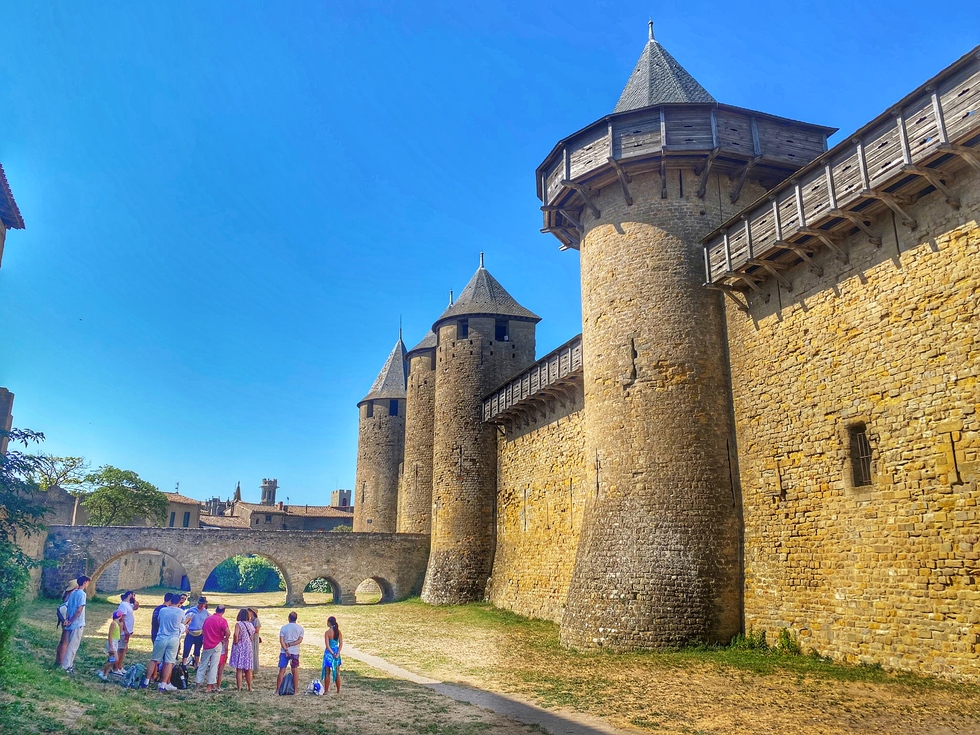The epic medieval poems “Chansons de Geste” tell how the city got its name. During a siege by Charlemagne when the city was under Muslim rule, the starving populace was near surrender until a local noblewoman, Dame Carcas, reputedly gathered up the last of their grain, fed it to a sow, and tossed the pig over the ramparts. The pig burst, scattering the grain. Dame Carcas then demanded a parley and cried, “Carcas te sonne!” (“Carcas is calling you!”) The Franks, concluding that Carcassonne must have unlimited food supplies, ended their siege. Like all such stories, it is not checkable and almost certainly apocryphal.
Carcassonne’s walls were further fortified by the vicomtes de Trencavel in the 12th century but the town was taken during the Albigensian Crusade by anti-Cathar troops under Simon de Montfort. In 1249 the city passed to Louis IX who laid out the ville basse. It was razed to the ground in 1355 by the English Black Prince during the Hundred Years War, then rebuilt by the citizens. By the mid-17th century, the city had lost its position as a strategic frontier, and the ramparts were quarried for their stones. But interest in the Middle Ages revived in the mid-19th century, and the government ordered Viollet-le-Duc (the restorer of Notre-Dame in Paris) to repair and, where necessary, rebuild the walls. He took considerable license when rebuilding the citadel to incorporate various very un-medieval features. In addition, the city today has an overabundance of souvenir shops, and silly attractions like virtual reality “tours” and torture museums. But what does that matter? Carcassonne casts its spell on all who come here.
To learn more about the city’s history—and it really is fascinating— you’ll want to visit the Chateau Comtal (see below) and also take a guided walking tour of the Cité. The Tourist Board hosts excellent, 1.5 hour, daily tours in English for 12€ per adult (7€ for children) at times that vary by season. In the course of the tour you’ll learn about a medieval Duke’s tragic betrayal, how World War II resistance fighters II used Cathedral passageways to spy on German officers, and stories of the residents who still live in the castle. Note that there are some steep areas to hike up during the tour. There’s also a tourist train that circles the ramparts of the old city, but its narration is only in French.
Pair the walking tour with a visit to the Château Comtal, pl. du Château (www.remparts-carcassonne.fr; [tel] 04-68-11-70-72; 9.50€ adults, free for children 17 and under; Apr-Sep daily 10am–6:15pm, Oct–Mar daily 9:30am–4:45pm), the restored 12th-century fortress defended by Raymond Trencavel then surrendered to the Crusaders in 1209. Though there is wall text in places, you’ll better understand what you’re seeing if you ante up the 5€ for an audio guide. It’s a bit goofy in parts (actors play the historic characters discussed) but overall is quite informative. You’ll see the archaeological remnants discovered on-site, view works of art in the small museum, and learn about both daily life in the middle ages and 19th-century restorations. The entrance to the castle/fortress is in the highest part of the Cité, on rue Cros Mayrevielle.
The major church of the Old City, Basilique St-Nazaire, pl. de l’Eglise (tel. 04-68-25-27-65), dates from the 11th to the 14th centuries and contains some beautiful stained-glass windows including two exceptional rose windows. It has other attractions: a soaring Romanesque nave, a gothic choir and transept, and the original tombstone of Simon de Montfort. The 16th-century organ is one of the oldest in southwestern France. The basilica is open Monday through Saturday 9am to noon and 2 to 7pm, Sunday 9am to 10:45am and 2 to 5pm. It closes slightly earlier in winter. Mass is celebrated on Sunday at 11am. Admission is free.
In the lower city are two worthwhile museums: the Musee des Beaux Arts (15 Blvd Camille Pelletan; free admission; daily 9:45am-12:30pm and 1:30-6:15pm) which has both contemporary art, and important pieces by Corot and Courbet; and the Musée De L'école (3 rue de Plo; 4€ admission; Tues-Sat 9:30am–12:30pm and 1:30-6pm) set in a former elementary school, with exhibits exploring what it was like to be a student in 1880 and 1960.
More info on all the sites discussed above can be found at www.tourisme-carcassonne.fr.
Note: This information was accurate when it was published, but can change without notice. Please be sure to confirm all rates and details directly with the companies in question before planning your trip.









